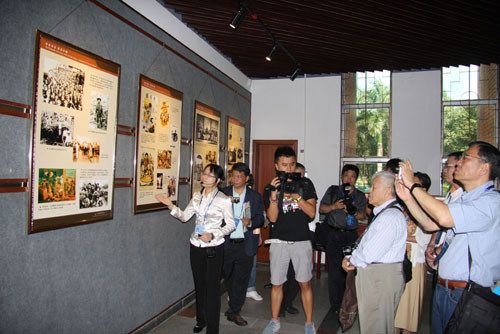Follow in the footsteps of the Xinhai Revolutionary martyrs
 0 Comment(s)
0 Comment(s) Print
Print E-mail
CRI, September 22, 2011
E-mail
CRI, September 22, 2011
A photographic exhibition of the Xinhai Revolution and overseas Chinese officially opened on Wednesday at the Guangdong Overseas Chinese Museum in Guangzhou, south China's Guangdong province. At the opening ceremony, two original relics stood out from the rest, attracting many visitors.
A dark green ceramic rice jar stands on a red wooden desk. A black-and-white photograph on the desk reveals the owner of the two items -- Du Fengshu, one of the 72 Martyrs of Huanghuagang in April 1911 during the Xinhai Revolution; which finally led to the overthrow of China's last imperial Qing Dynasty. The picture shows a handsome man, wearing dark clothing.
Du's descendants, Du Ziming and his wife also participated in the opening ceremony. Du told CRI that he recently donated the two objects, the desk and the rice jar, to the Guangdong Overseas Chinese Museum. The photo on display, which was taken when Du Fengshu worked in Singapore, is a reproduction of the original copy which was donated to the Guangdong Museum of Revolutionary History.
Du Ziming's grandfather was Du Fengshu's only brother. He shared with pride the story of Du Fengshu; but there was also a sense of melancholy in Du Ziming's voice.
Du Fengshu was born in a small Guangdong village. Poverty forced him to quit school during his early years. As a result, Du left the village to work in Guangzhou, Hong Kong and Singapore. As he matured, he embraced Sun Yat-sen's revolutionary ideas and tried to collect money for the revolution.
Du Ziming noted that before Du Fengshu returned to China to join the Guangzhou Uprising or Huanghuagang Uprising, he and his acquaintances cast lots to decide who would stay abroad and who would return to join the Guangzhou Uprising. The result of the draw meant that Du was to stay in Singapore, but he changed his result with another workmate and returned to take part in the uprising in Guangzhou.
During the Guangzhou Uprising, Du, who was familiar with the landscape of Guangzhou, charged forward. He was quickly shot in his left eye. However, Du continued to attack the then Guangdong governor's office, and later died at the age of 28 due to complications from his wounds.
Since Du Fengshu's heroic death, his fellow villagers have commemorated his feat. After the success of the War of Resistance against Japanese Aggression, the villagers converted their ancestral hall into two commemorative schools.
In 2001, the villagers pooled money and built a memorial hall on the foundations of their ancestral hall.
Now, Du's descendants have donated his relics to the Chinese government in order to preserve his memory and pass on the hero's story.
After listening to Du Fengshu's story, I was moved by his persistence in pursuing a rejuvenated Chinese nation. It is a comfort to see the dream of Sun Yat-sen and the Xinhai revolutionary martyrs coming true after China's 30 years of reform and opening-up. Today, China is becoming more and more powerful.
When the Du Fengshu memorial school was founded over 60 years ago, the lyrics of the school song read, "We hope the Chinese people will follow in the footsteps of the Xinhai revolutionary martyrs, rescue China, rejuvenate China and make China immortal". The song reflected the will of the Xinhai revolutionary martyrs, and when we mark the centenary of the Xinhai Revolution, it is only right that we should continue to follow in their footsteps and carry forward the great idea of China's rejuvenation and national reunification.






